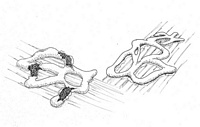|
 Hemitrichia serpula Hemitrichia serpula
SynonymsArcyria serpula
Hemiarcyria serpula
Mucor serpula
Hyporrhama serpula
BiostatusPresent in region - Indigenous. Non endemic
Images (click to enlarge)
Caption: Two small plasmodiocarps of Hemitrichia serpula. The one on the left is about 5 mm broad.
Owner: S.L. Stephenson |
Article: Stephenson, S.L. (2003). Myxomycetes of New Zealand. Fungi of New Zealand. Ngā Harore o Aotearoa 3: xiv + 238 p. Hong Kong: Fungal Diversity Press.
Description: Fruiting body a plasmodiocarp, the individual elements terete, 0.4–0.6 mm in diameter, these branching freely and usually forming a definite reticulum that is often several centimetres in extent. Peridium persistent, membranous, transparent, somewhat thicker below and splitting longitudinally to expose the spore mass, bright yellow to rusty or brownish yellow. Hypothallus usually evident, contiguous for the entire plasmodiocarp, ranging from colourless to reddish brown. Capillitium a tangled mass of sparingly branched yellow threads, spiny, 4–6 µm in diameter, with spiny free tips. Spores golden yellow in mass, pale yellow by transmitted light, coarsely reticulate, 10–16 µm in diameter. Plasmodium white, then becoming yellow when fruiting.
Habitat: Decaying wood, wood debris, and old decaying palm fronds.
Distribution: Reported as cosmopolitan (Martin & Alexopoulos 1969), although apparently uncommon at high latitudes (Stephenson et al. 2000) and sometimes exceedingly abundant in tropical forests (Stephenson et al. 2001). First reported (as Hemiarcyria serpula) from New Zealand by Colenso (1885), based on specimens collected in Rangitikei/Hawkes Bay. Also known from Auckland, Taupo, Wellington, Buller, Westland, and Southland.
Notes: This species is one of the more distinctive and easily recognised of all myxomycetes.
|